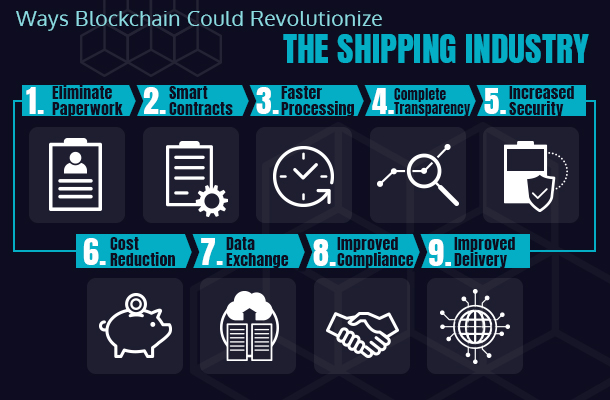As we are living in a technology-driven world, every complex or little thing seems to be just a click away! Electronic appliances, gadgets, faster modes of transportation, etc. have added to the comfort factor in our lives.
Maritime trading companies have always used traditional methods of transportation and correspondence, such as bulk carriers, cargo ships, radio signals, and more. These days, however, with the introduction of revolutionary technology and ideas, it has become imperative for the trade industries to adopt new technological trends for providing an even faster and more efficient trade service. After taking into account a number of variables, autonomous technology refers to providing software a greater degree of independence in making critical judgments. The internet of things is a new technology that allows people to link ordinary devices to the cloud or the internet. With the press of a button, anyone can control ordinary things. The next one on our list is Blockchain Technology. So what exactly Blockchain Technology is and how it can be used in shipping?
Blockchain Technology is a system of recording information in a way that makes it difficult or impossible to change, hack, or cheat the system. A blockchain is essentially a digital ledger of transactions that is duplicated and distributed across the entire network of computer systems on the blockchain.
Blockchain technology has a significant impact on the shipping sector, with many shipping organizations looking forward to having information flow more seamlessly between company categories and trade-related office operations faster and more efficiently. Though there are several challenges for the technology’s implementation, including industry standards, meeting regulatory expectations, and the emergence of a leading blockchain technology platform, shipping industry participants must be prepared for blockchain technology because the technology is coming, and companies must be prepared to take advantage of this game-changing technology.
Suppose a vast network of computers that have all access to the same file. The network is configured to automatically update the file on a regular basis. When you add a transaction on one system, it is automatically added to the file on the other system. The network also compares all copies of these files to guarantee that they are all accurate. There is no centralized file that can be accessed and modified. If one of the files is edited, the verification mechanism will detect and correct the issue unless the majority of the network approves the modification. While blockchain was first meant to facilitate safe financial transactions between numerous parties without the need for an intermediary such as a bank, it now functions as a decentralized, secure, and encrypted database. The utilization of blockchain, as a secure, decentralized, and encrypted public ledger, might be utilized in a variety of applications in shipping, bringing about a revolution in the way commerce is conducted, similar to the change that OpenSea brought to the industry in the way ship chartering is conducted. Blockchain has the potential to transform the entire process into a paperless paradise in which all related parties in each transaction (i.e. cargo sellers/buyers, ship-owners, charterers, banks, agents, customs, port authorities, etc.) could interact with one another, perform physical transactions, exchange and store information using public and private keys.

Setting up blockchain technology for the shipping business has a number of advantages, including Quick processing and real-time updates – Instead of shipping documents to all parties involved, these same documents may be transferred quickly, and procedures can be completed in minutes. Higher Accuracy – Because the paperwork will be filled out and processed mechanically rather than manually, human error in the paper process is eliminated. Increased Security – The blockchain code contains all information that is encrypted. Full Transparency – The data saved in this sort of system are completely transparent and are accessible to anyone who has the access key, Cutting Costs – The costs associated with maintaining proper old-fashioned documentation are surprisingly high, especially when you take procedural delays, discrepancies, and human errors into account. Easier Access to the Market – Everyone in the industry will have access to the technology, lowering the barriers for entry and making the market more competitive.
Challenges of Blockchain Technology although there are numerous benefits to blockchain technology, there are a few hurdles that the shipping sector will encounter when it begins to use it. Let’s look at some of the issues that the industry will encounter throughout the shift:
Global Adoption – This form of technology is not yet permitted in every country. Because several governments and organizations are involved in all sectors of the trading business, it will take some time to get everyone on board with the technology. To make it easy to use throughout the world, it would need to be universally adopted, particularly in the shipping sector.
Special Contractual Terms – Ship chartering, as well as the sale and purchase of commodities that must travel large distances and traverse countries, are complicated challenges. Blockchain technology would necessitate the adaptation of some words. It must be able to track parameters such as laytime, a notice of readiness, and the precise time the vessel is due to arrive in port.
Greater Flexibility – Most stakeholders in the shipping sector have their own set of conditions that are usually adjustable. To be able to achieve this with blockchain technology, the particular terms and conditions must be configured at the start of the shipment. If not, both parties involved may face increased culpability.
Automation Equals Fewer Jobs – As with any sector, the more duties we delegate to technology, the less positions there are to be filled by humans. This persistent issue will have to be addressed on a worldwide basis in the next decades. All things considered, this is a great step forward for the transportation business. While there are still many obstacles to overcome, it will bring the shipping sector into the twenty-first century and greatly simplify documentation. This industry will become more competitive as records, travel routes, and terms become more accessible. Costs will be reduced, and information will be less vulnerable to human mistakes.
To be continued…






